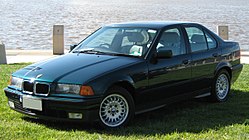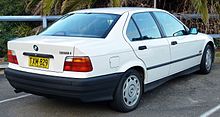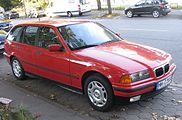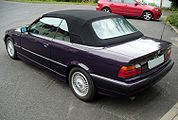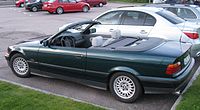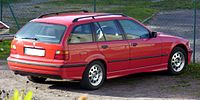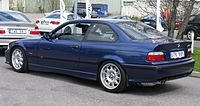BMW E36
| BMW | |
|---|---|
|
BMW 318i (1990-1994)
|
|
| E36 | |
| Sales designation: | 3 series |
| Production period: | 08 / 1990-2000 |
| Class : | Middle class , compact class |
| Body versions : | Sedan , hatchback , station wagon , coupe , convertible |
| Engines: |
Otto engines : 1.6–3.2 liters (60–245 kW) Diesel engines : 1.7–2.5 liters (66–105 kW) |
| Length: | 4210-4433 mm |
| Width: | 1698-1710 mm |
| Height: | 1335-1393 mm |
| Wheelbase : | 2700 mm |
| Empty weight : | 1140-1535 kg |
| Previous model | BMW E30 |
| successor | BMW E46 |
| Stars in the Euro NCAP - Crash Test |
|
The E36 series is the third 3 series from the car manufacturer BMW . It was presented in August 1990 as the successor to the E30 series and built as a sedan until February 1998. The BMW Compact and Z3 models were also built using the technology of the E36 . From February 1998 the E36 was continuously replaced by the successor E46 . The Compact was discontinued in September 2000, the Z3 followed in December 2002. A total of 2,745,773 BMW E36s were built, with the exception of the Z3.
The diversity of the E30 variants was largely continued with the E36, but there was no longer all-wheel drive for this series . This was only offered again for the E46. A sporty version with the most powerful six-cylinder engine ( BMW M3 ) was also available. The designer of the BMW E36 was Pinky Lai.
The sedan, coupé, touring, convertible and compact of the E36 series are described below. For roadsters and coupé based on the roadster, see BMW Z3 .
Model history
General
In August 1990 the new generation of the BMW 3 Series was presented. BMW further developed its traditional design language: The double round headlights were now located under a shared glass cover. The shape of the body was strongly influenced by aerodynamic parameters. The rear axle was a central link axle. The wheel carrier was rotatably mounted directly on the floor pan via a boom and guided laterally with two wishbones. It had been developed for the BMW Z1 Roadster and was also installed there.
In this series, the two-door sedan (in the previous model still with the same dimensions as the four-door) was replaced by a flatter and wider coupé in March 1992. The body was heavily modified in almost every detail, although this is not necessarily noticeable on cursory inspection. The convertible that had been diverted from the coupé appeared in April 1993. The Touring station wagon version did not come onto the market until January 1995.
In April 1994, the three-door Compact version with a rear approximately 20 centimeters shorter was added to the range. Initially equipped with a rear antenna, it was then available with a rear window antenna from 1995.
For the Compact, BMW continued to use some of the E30 designs, for example the rear axle construction ( semi-trailing arm axle ). This does not mean, as is often wrongly claimed, that it is the same axle as the E30, as various bearing dimensions on the axle beam and semi-trailing arm are different. The dashboard was a new development, although the cylindrical ventilation grille and various switches still reminded of the E30. The 316i Compact was delivered with a 1.9 liter engine between May 1999 and September 2000. With a torque of 165 Nm at 2500 rpm, this 77 kW engine can be driven somewhat more “flexibly” than the 1.6 l engine up to May 1999 with 150 Nm at 3900 rpm. Outside Germany there were also other engine and body combinations, for example the US version of the 318i convertible from 1996 onwards had the M44 engine with 103 kW.
The models from the initial series have an unusually poor body quality by BMW standards, which was evident in numerous squeaking and rattling noises, but also led to strong wind noises, especially on the headlights and side mirrors, due to the poor fit of body parts. These models were also susceptible to corrosion, which is why BMW very soon set aside provisions in order to be able to buy these early models from the market in order to avoid damage to their image from rusty vehicles. The vehicles from this start-up series were also scolded in the German-speaking media for having too spontaneous steering, which allegedly made it difficult to drive fast.
These vehicles can be recognized by a panel above the glove compartment between the center console and the air vent on the passenger side made of smooth hard plastic.
BMW reacted quickly to these deficiencies and, for example, introduced headlight glasses that had small spherical "protrusions" in the glass on their upper edge and thus suppressed the strong whistling noises in the bonnet joint at this point by other turbulence. Manufacturing quality and rust prevention have been improved and a significantly higher quality of paintwork has been achieved. The too spontaneous steering criticized by the German media was also changed by modifications to the front axle, which made it much less spontaneous, especially around the central position, which was praised in the German media, but sometimes heavily criticized abroad. This and all subsequent production series can be recognized by a panel in the dashboard above the glove compartment between the center console and the passenger air vent with an insert made of grained plastic similar to the door panels.
The poor fit of body parts in the intensified competition remained a characteristic feature of the E36, as did the resulting sometimes coarse gap dimensions. In the case of the four-door sedans, the window frames formed from the door panel, which are also tricky in terms of production technology and are always susceptible to wind noise, are particularly affected by the four-door sedans. In the case of the rear doors, despite the wide rubber seals used, the transition to the roof and the C-pillar is a definite weak point, which is almost always not designed to meet the requirements and price range. For this reason, BMW also dispensed with this design feature in the successor model and again used conventional window frames on the doors.
In October 1991 the suspension of the stabilizer and its linkage were modified. Before this date, the front axle stabilizer on all E36s was hinged to the strut via a longer, upward-pointing pendulum support, as was the case with the M3 throughout production.
design
The E36 has a sloping front, it no longer protrudes to the front as in older BMW types. This made great progress in the field of pedestrian protection. In accidents with pedestrians, they were more likely to "roll" over the hood and were no longer seriously injured from the protruding front section - as was often the case in the past. The double headlights were now behind a glass cover and the rear was pulled higher. The instrument panel was more rounded and delicate than on the previous E30. A design element that can only be found on the E36 in a comparison of the BMW sedans is the strong door frames that extend right into the roof, a design principle that was also applied to the Golf III, which was introduced around the same time .
What was new with the E36 was the fact that the two-door version was given an at least formally independent body and was henceforth referred to as a coupé. While the seat position remained the same, the front section was lengthened by moving the windshield back and shortening the dashboard to compensate. The doors are not only longer - as is usual with two-door models - they also have no window frames. In addition, the roof and the rear section, including the rear lights, are flatter on the Coupé.
Passive safety
In a crash test conducted by auto motor und sport in 1991, the E36 scored "good" according to the evaluation standards at the time. The vehicle was driven against a non-deformable, 100-ton concrete block with 50 percent overlap and 55 km / h. The risk of injury was classified as low and the deformation of the body as significant. The vehicle tested was a 325i without airbags. The performance in a crash test carried out by BMW was also called "good" at the time. BMW let the E36 Compact hit a 100-ton concrete block at 60 km / h.
According to the criteria of the Euro NCAP crash test, which is now used as a reference , the vehicle was examined again in 1997, with the E36 performing poorly. The tested 3-seater sedan received two out of five stars in the assessment of occupant safety by adults, one of which was revoked because of a particularly high risk of injury in the driver's seat. However, other cars with a design dating from the E36 era have similarly serious safety deficiencies. Many of the vehicle types of that time were no longer assessed by the Euro NCAP crash test, as they were no longer produced after 1996/97, while production of the E36 continued until 2000. As with many cars from other manufacturers, crash safety was significantly improved in the following model generations - the BMW E46 received four out of five stars, the E90 five stars.
Body styles
Sedan and Touring (1990 to 1996)
Coupé, Cabrio and Compact (1990 to 1996)
Facelift
The E36 series was one of the few 3-series that managed without major visual model maintenance measures. Technically, however , numerous changes were made with each model year (from September after the factory holidays , designated after the following calendar year).
In September 1993 the E36 received its first light facelift. The headlights and exterior mirrors were provided with knobs on the top to reduce air turbulence and the resulting noises, the front bumper was replaced by a modern-looking variant. In addition, from model year 1993 onwards, the E36 received standard side indicators in the fender.
The most obvious feature of the model update measures on the E36 from spring 1996 onwards were small changes to the headlights (lighting technology) and the indicators in the fender, as well as the BMW kidney grille and the front and rear bumpers.
While the first models still had H1 lens headlights and light gray plastic bumpers with large cooling air openings, the model upgrade included H7 headlights in freeform technology, aerodynamically optimized exterior mirrors and headlight covers (each with small knobs to protect against wind noise) as well as side indicators in the fenders.
In addition, the modified vehicle had a slightly V-shaped and outwardly curved BMW kidney grille as well as side skirts and plastic bumpers colored in darker gray with a finely ribbed cooling air inlet and a continuous horizontal joint. The reason for this is that the bumpers could now also be ordered in the color of the vehicle (up to this joint) for an additional charge.
The standard full plastic wheel covers retained their basic design, but with the facelift they were made a little softer and more three-dimensional and given a more glossy clear coat. In the interior, the facelift was made clear by new upholstery colors and fabrics (flat weave). In addition, the driver's airbag became standard. When the front passenger airbag was ordered, the cockpit was given a slightly more modern shape, as the storage tray in front of the front passenger seat was omitted and the cockpit was slightly angled here. In the further course, the models were also given a visually much more attractive airbag steering wheel with a colored BMW emblem (previously only embossed in the plastic).
Body styles (1996 to 1998)
BMW M3
The second version of the M3 (E36 series) was presented by BMW Motorsport GmbH in summer 1992 . In the first production phase it was based on the two-door coupé, later it was supplemented by a sedan and convertible. It has an in-line six-cylinder petrol engine ( S50B30 ) with 2990 cm³ displacement and four valves per cylinder. It develops 210 kW (286 hp) and has fully variable VANOS (inlet camshaft only, steplessly with high pressure). The maximum torque is 320 Nm at 3600 min -1 .
With a revision of the engine (S50B32), it developed 236 kW at 7,400 rpm with a displacement of 3.2 liters, received a 6-speed gearbox and was the first BMW vehicle with double vanos .
The considerably increased engine power of the M3 E36 compared to its predecessor called for a revision of the chassis and the braking system. With the M3 3.2, a compound brake system was introduced at the front .
Special models
From 1994 to 1995 the special model 318iS Class II was built, which was only available as a sedan. A homologation series of 2500 pieces, 1000 of them in Germany, worldwide for the STW series. It was built at the same time as the M3 GT and adopted some optical features. In addition to the standard M package, an "M lip" with so-called GT corners / GT flaps was also installed on the front bumper. Furthermore, the two-part rear spoiler of the M3 GT was adopted. The limited edition of the M3 GT (356 copies) was only manufactured and delivered in the color British Racing Green . The interior of the M3 GT was decorated with some real carbon applications.
| Period | designation | Motorization (s) | Body shape (s) | number of pieces | Brief description |
|---|---|---|---|---|---|
| 1994 | M3 | S50B30 | Coupe | 45 | The EU spec was sold in Canada until 1996, then the US spec was regularly sold. |
| 1994-1995 | 318is Class II | M42B18 | limousine | 2500 (1000 for Germany) | Homologation model for STW series. |
| 1994-1995 | M3 GT | S50B30 with increased performance | Coupe | 65 | Homologation model for FIA GT class II, IMSA GT and endurance races. A privately operated English language website lists information on all vehicles built. |
| 1995 | M3 LTW (lightweight) | S52B30 | Coupe | For US market only. | |
| 1996 | M3 Compact | S50B32 | Compact | 1 | Unique item for the anniversary of "Auto Motor und Sport" magazine. The vehicle was raffled off in a competition organized by the magazine. |
| 1997 | M clubsport | 318is, 320i, 323i, 328i | Coupe | 500 | Only for Germany. |
| 1998 | M3 Evo Imola Individual | S50B32 | Coupe | 50 | For UK market only. Often mistakenly referred to as GT2. |
| 1998 | M3 GT Individual | S50B32 | Coupe | 50 | For UK market only. M3 GT look |
| 1999 | M3 Anniversary Edition | S52B32 | Coupé, convertible | 50, 70 | For Australia only. |
Technical data and engine variants
The E36 was built with the following engine variants as standard:
Petrol engines
| model | Cylinders / valves |
Displacement | Max. power | Max. Torque | Acceleration 0-100 km / h (s) |
Engine code | Construction period | variant |
|---|---|---|---|---|---|---|---|---|
| 316i | 4/8 | 1596 cc | 73 kW (99 hp) at 5500 min -1 | 141 Nm at 4250 min -1 | 12.7 [13.2] | M40-B16 | 08.1990-08.1993 | limousine |
| 316i | 4/8 | 1596 cc | 75 kW (102 hp) at 5500 min -1 | 150 Nm at 3900 min -1 | 12.7 [13.2] | M43-B16 | 08.1993-05.1999 | Sedan, Touring, Coupé, Compact |
| 316 g | 4/8 | 1596 cc | 60 kW (82 hp) at 5500 min -1 | 127 Nm at 3900 min -1 | 15.6 | M43-B16 | 03.1995-09.2000 | Compact |
| 316i | 4/8 | 1895 cc | 77 kW (105 hp) at 5300 min -1 | 165 Nm at 2500 min -1 | 12.7 [13.2] | M43TÜ -B19 | 05.1999-09.2000 | Compact |
| 318i | 4/8 | 1796 cc | 83 kW (113 hp) at 5500 min -1 | 165 Nm at 4250 min -1 | 11.3 | M40-B18 | 08.1990-08.1993 | limousine |
| 318i | 4/8 | 1796 cc | 85 kW (115 hp) at 5500 min -1 | 168 Nm at 3900 min -1 | 11.3 [11.7] (12.5) | M43-B18 | 08.1993-05.1999 | Sedan, touring, convertible |
| 318is / ti | 4/16 | 1796 cc | 103 kW (140 hp) at 6000 min -1 | 175 Nm at 4500 min -1 | 10.2 | M42-B18 | 10.1991-01.1996 | Sedan, coupé, compact |
| 318is / ti | 4/16 | 1895 cc | 103 kW (140 hp) at 6000 min -1 | 180 Nm at 4300 min -1 | 10.2 | M44-B19 | 01.1996-05.1999 | Sedan, coupé, compact |
| 320i | 6/24 | 1991 cc | 110 kW (150 hp) at 6000 min -1 | 190 Nm at 4700 min -1 | 9.9 [10.2] (10.6) | M50-B20 | 08.1990-04.1995 | Sedan, coupé, convertible |
| 320i | 6/24 | 1991 cc | 110 kW (150 hp) at 5900 min -1 | 190 Nm at 4200 min -1 | 9.9 [10.2] (10.6) | M52-B20 | 09.1994-05.1999 | Sedan, touring, coupé, convertible |
| 323i / ti | 6/24 | 2494 cc | 125 kW (170 hp) at 5500 min -1 | 245 Nm at 3950 min -1 | 8 [8.3] 7.8 | M52-B25 | 06.1995-09.2000 | Sedan, touring, coupé, convertible, compact |
| 325i | 6/24 | 2494 cc | 141 kW (192 hp) at 6000 min -1 | 245 Nm at 4700 min -1 | 7.9 (8.6) | M50-B25 | 08.1990–01.1995 | Sedan, coupé, convertible |
| 328i | 6/24 | 2793 cc | 142 kW (193 hp) at 5300 min -1 | 280 Nm at 3950 min -1 | 7.3 [7.4] (7.7) | M52-B28 | 01.1995-05.1999 | Sedan, touring, coupé, convertible |
| M3 | 6/24 | 2990 cc | 210 kW (286 hp) at 7000 min -1 | 320 Nm at 3600 min -1 | 6.0 (6.2) | S50-B30 | 10.1992-10.1995 | Sedan, coupé, convertible |
| M3 GT | 6/24 | 2990 cc | 217 kW (295 hp) at 7000 min -1 | 323 Nm at 3900 min -1 | 5.8 | S50-B30 | 12.1994-06.1995 | Coupe |
| M3 | 6/24 | 3201 cm³ | 236 kW (321 hp) at 7400 min -1 | 350 Nm at 3250 min -1 | 5.5 (5.6) | S50-B32 | 10.1995-04.1999 | Sedan, coupé, convertible |
Diesel engines
| model | Cylinders / valves |
Displacement | Max. power | Max. Torque | Acceleration 0-100 km / h (s) |
Engine code | Construction period | variant |
|---|---|---|---|---|---|---|---|---|
| 318 tds | 4/8 | 1665 cc | 66 kW (90 hp) at 4400 min -1 | 190 Nm at 2000 min -1 | 14.2 [14.5] | M41-D17 | 03.1995-09.2000 | Sedan, Touring, Compact |
| 325td | 6/12 | 2498 cc | 85 kW (115 hp) at 4800 min -1 | 222 Nm at 1900 min -1 | 12 | M51-D25 | 01.1991-02.1998 | limousine |
| 325tds | 6/12 | 2498 cc | 105 kW (143 hp) at 4800 min -1 | 260 Nm at 2200 min -1 | 10.4 [10.5] | M51-D25 | 06.1993-05.1999 | Limousine, touring |
Alpina engine variants
| model | Cylinders / valves |
Displacement | Max. power | Max. Torque | Acceleration 0-100 km / h (s) |
number of pieces | Construction period | |
|---|---|---|---|---|---|---|---|---|
| B6 2.8 | 6/24 | 2752 cc | 177 kW (240 hp) at 5900 min -1 | 293 Nm at 4700 min -1 | 6.9 | 136 | 03.1992-07.1993 | |
| B3 3.0 | 6/24 | 2997 cc | 184 kW (250 hp) at 5700 min -1 | 320 Nm at 4400 min -1 | 6.1 [6.2] (6.8) | 749 | 04.1993-03.1996 | |
| B3 3.2 | 6/24 | 3152 cc | 195 kW (265 hp) at 5800 min -1 | 330 Nm at 4400 min -1 | 5.9 [6.0] (6.6) | 342 | 04.1996-03.1999 | |
| B8 4.6 | 8/32 | 4619 cc | 245 kW (333 hp) at 5700 min -1 | 470 Nm at 3900 min -1 | 5.6 [5.7] (5.8) | 221 | 01.1995-11.1998 | |
- ↑ a b c Values in [] brackets apply to the Touring, values in () brackets apply to the Cabrio.
- ↑ Bivalent drive with petrol / natural gas (CNG), when operated with petrol the engine has an output of 75 kW (102 PS). The gas tank is mounted as a cylinder tank instead of the back seat, making the 316 g a pure two-seater.
- ↑ The 316i Compact was delivered between May 1999 and September 2000 with a 1.9 liter engine, which is internally called the M43TU (M43B19).
- ↑ From model year 1993 (engine M50 B20TU, with VANOS) 190 Nm at 4200 min -1
- ↑ Only with compact version
- ↑ The 323i was also offered as a convertible abroad.
- ↑ From model 1993 (motor M50-B25TU with VANOS) 250 Nm at 4200 min -1
- ↑ Factory information - according to AMS test 6.4 s
Production periods
| Model variant | designation | from | to |
|---|---|---|---|
| limousine | E36 / 4 | August 1990 | April 1998 |
| Coupe | E36 / 2 | February 1992 | April 1999 |
| Convertible | E36 / 2C | April 1993 | April 1999 |
| Compact | E36 / 5 | April 1994 | September 2000 |
| Touring | E36 / 3 | January 1995 | May 1999 |
| M3 coupe | E36 / 2S | October 1992 | April 1999 |
| M3 convertible | E36 / 2CS | January 1994 | April 1999 |
| M3 sedan | E36 / 4S | August 1994 | February 1998 |
Baur top convertible
From Baur there was a four-door convertible sedan (Baur-TC4) built in 310 copies. The sedan served as the basis, from which the rear window and most of the roof, but not the window frames, were removed. A fabric hood stretched forward over the C-pillars from behind . At the level of the B-pillar , a cross member of the roof was retained for stiffening, to which the convertible top could be attached when it was half open. In this position, the vehicle looked like a limousine with a slightly enlarged, open sunroof. The TC4 could be ordered with any gasoline or diesel engine available for the 3-series sedan.
Roadster Z3
The Roadster Z3 (produced from October 1995 to December 2002) ran under the designation E36 / 7 ; its coupé variant was called the E36 / 8 . Both are based on the platform of the E36 Compact and also share various parts in the interior.
The E36 in motorsport
Like its predecessor, the E30, the E36 was used in touring car racing at the factory. Joachim Winkelhock competed in the British Touring Car Championship from 1993 to 1995 and became champion there in 1993. In the same year, Johnny Cecotto won the ADAC GT Cup in a BMW M3. Both drivers competed successfully for BMW in the Super Touring Car Cup . Cecotto became champion in 1994 and 1998, Winkelhock in 1995.
The 24-hour race at the Nürburgring was won from 1994 to 1998 with the BMW E36, with the 320d winning a vehicle with a diesel engine for the first time in 1998. The E36 was and is popular in mass sport, so drivers on E36 were overall winners of the VLN endurance championship Nürburgring in 1998, 2002, 2004 and 2006 .
literature
- Hans-Rüdiger Etzold : This is how it's done (Volume 74): BMW 3 Series Type E36 . Delius Klasing, Bielefeld 1998, ISBN 3-7688-0733-9
Web links
Individual evidence
- ↑ a b BMW 3 Series (1997). (PDF) Euro NCAP, accessed on November 29, 2015 .
- ↑ BMW AG (Ed.): BMW 3 Series (E36) series . Retrieved April 3, 2018
- ↑ 25 years Z1 at auto.de , accessed on April 30, 2018.
- ^ Greg Hudock: BMW 3 Series - E36 Restoration Tips & Techniques . Brooklands Books, 2012, ISBN 978-1-85520-970-1 ( limited preview in Google Book Search). In particular, chapter 1, subtitle for Figure 1.3. Retrieved April 30, 2018.
- ↑ Gert Hack: On the safe side. In: auto motor und sport 15/1991. Pp. 12-17 , accessed November 29, 2015 .
- ^ Hans-Hermann Braess, Ulrich Seiffert: Handbook of Automotive Engineering . Ed .: SAE International. 2005, ISBN 978-0-7680-0783-1 . Page 496
- ↑ ADAC GT Cup class 1 1993 standings | Driver Database. Retrieved October 17, 2018 .
- ↑ All VLN Masters at a glance | VLN.de . In: VLN.de . ( vln.de [accessed October 17, 2018]).
| Timeline of the glass series models from 1955 to 1969 | |||||||||||||||||||||
|---|---|---|---|---|---|---|---|---|---|---|---|---|---|---|---|---|---|---|---|---|---|
| Type | independent (Hans Glas GmbH) | BMW | |||||||||||||||||||
| 1950s | 1960s | 1970s | |||||||||||||||||||
| 5 | 6th | 7th | 8th | 9 | 0 | 1 | 2 | 3 | 4th | 5 | 6th | 7th | 8th | 9 | 0 | 1 | 2 | 3 | 4th | ||
| Microcar | Goggomobil T | ||||||||||||||||||||
| Small car | Isar ("large Goggomobil") | ||||||||||||||||||||
| Lower middle class | 1004, 1204, 1304 | ||||||||||||||||||||
| Middle class | 1700 | 1800 SA, 2000 SA / 1804, 2004 [1] | |||||||||||||||||||
| Coupe | Goggomobil TS | ||||||||||||||||||||
| 1300 GT, 1700 GT | 1600 GT [2] | ||||||||||||||||||||
| 2600 V8, 3000 V8 | 3000 V8 [3] | ||||||||||||||||||||
| Vans | Goggomobil TL | ||||||||||||||||||||
|
|
|||||||||||||||||||||
